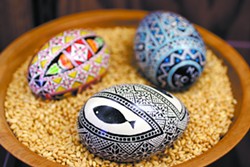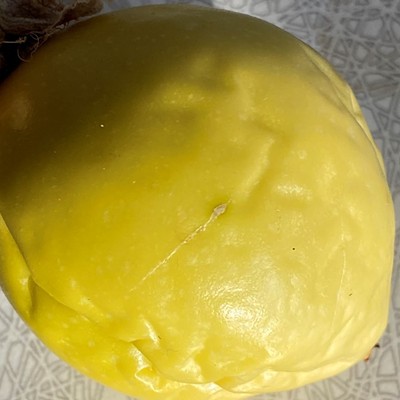For all their intricacy and fragility, creating Ukrainian-style eggs isn’t as hard as it might seem. Not only has Moscow’s Margaret Dibble been making them for the past 30 years, she’s passed on the skill to dozens of students of all ages.
In anticipation of her upcoming class at Artisans at the Dahmen Barn, here are some potential steps in making a Ukrainian-style egg:
Join a folk dance group It might not be the most direct route to creating Ukrainian-style eggs, but it’s the one Dibble took. Thirty years ago, when she joined the Washington State University International Folk Dancers (now International Folk Dancers of the Palouse), she had no idea that it came with egg-making lessons. Locally made Ukrainian eggs have been a longtime annual fundraiser for the group, so Dibble joined in — first watching, then helping, then creating using borrowed supplies, until finally she was doing it all on her own. She still creates about a dozen eggs every year. (This year’s fundraiser will be 11 a.m. to 1:30 p.m. April 9 to 11 at the Compton Union Building on the WSU campus.)
Buy a duck Duck eggs are Dibble’s favorite type for Ukrainian-style eggs. Not only are they a bit larger than chicken eggs, but the shells tend to be stronger and smoother and absorb the dye well, Dibble says. Commercial chicken eggs have thin shells, and goose eggs are rough. Don’t have space for a duck? Make some duck-owning friends or visit the Moscow Food Co-op.
Prep the egg Ukrainian-style eggs can be left intact or drained of their contents. Intact eggs are decorated raw; the inside of the egg hardens over time and can last for decades. The trouble is, if not stored correctly, the intact egg is prone to burst, creating a sad, stinky mess. Instead of taking the risk, Dibble drains her eggs. Preparing the eggs this way not only utilizes the delicious interior but avoids the unpleasant possibility of egg-burst.
Buy a kitsky Ukrainian-style eggs are not painted; they’re dyed using a wax-resist process similar to batik. To create her eggs, Dibble draws a traditional design on the egg in pencil. Then she uses a “kitsky” to apply beeswax to the parts that are to remain white. Working from light to dark, the egg is dyed with a light color, wax is added to the parts remaining that color, dyed again in a slightly darker color and so on until the design is complete. The wax is removed from the egg at the very end. This slow process can take days.
Take a class Perhaps the most direct way to learn to make Ukrainian-style eggs is to take a class, which Dibble is offering Sunday. All supplies are provided, and no experience is necessary. Participants need to bring only themselves and an ability to focus on detailed work. The class is open to kids age 8 and older who are accompanied by an adult — after all, there is hot wax and an open flame involved in the process. Participants will complete two eggs, which will be varnished and available for pick up the following week.
If you go: WHAT: Ukrainian-Style Egg Decorating WHEN: 1:30 to 5 p.m. Sunday WHERE: Artisans at the Dahmen Barn, 419 N. Park Way in Uniontown COST: $15/adults, $12/kids 8 to 16 years accompanied by an adult. Register by Friday at www.artisanbarn.org or by calling (509) 229-3414. (Registration discount for children only available via phone.)





















